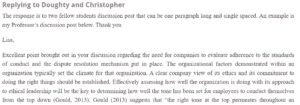Replying to Doughty and Christopher
Replying to Doughty
Hello Doughty,
The integration of the industry code of conduct into the organization’s internal code is one of the ways to succeed in implementing the set industry’s standards in a company and reduce impropriety. However, this does not happen without the efforts of the leadership to lead by example so that the codes can be replicated in all levels of governance of an organization. The adherence to the company’s set code of conduct must begin at the top with the rest of the stakeholders borrowing a leaf from the leaders (Gould, 2013). Also, addressing every area of management and operations of a company in the code of conduct is probably another determinant of Arconic Inc.’s success as they have all these covered in their code of conduct. Further, their code has an evaluation mechanism that helps determine if the employees’ conduct reflect the company’s and industry’s aspirations and it allows for consultations to effect necessary changes. Arconic is also poised to succeed in its operations for its adherence to the basic minimums in drafting of its code of ethics which incorporates all the areas addressed in (Stanwick & Stanwick, 2016). Our assignment writing help is at affordable prices to students of all academic levels and academic disciplines.
References
Gould, S. (2013, November 5). Ethical leadership and developing a code of conduct for organizations. Retrieved from Global Knowledge Gateway: http://www.ifac.org/global-knowledge-gateway/ethics/discussion/ethical-leadership-development-code-coduct
Stanwick, A. P., & Stanwick, D. S. (2016). Understanding business ethics (3rd ed.). Thousand Oaks, CA: SAGE Publishing.
Replying to Christopher
Hello Christopher,
As is expected with any multinational like IBM, protecting the company’s interests in the market is a priority for the investors. Also, in adherence to the set industry’s standards, providing a safe working environment, including a clause on the treatment of employees with respect and dignity, captures this expectation in IBM’s code of ethics. Nonetheless, the failure of the company to address the gray areas in its outsourcing policies opens a window of exploitation and abuse by its suppliers and even the company’s personnel. There is a need for the company to cover all its stakeholders in the code of conduct. This way, suppliers who are as important as the internal management staff in maintaining the company’s reputation in public can live by the standards set by the company (Stanwick & Stanwick, 2016). Also, the company’s leadership must inculcate a culture of respect to the industry’s labor policies to avoid non-compliance by some of its stakeholders.
References
Stanwick, A. P., & Stanwick, D. S. (2016). Understanding business ethics (3rd ed.). Thousand Oaks, CA: SAGE Publishing.
ORDER A PLAGIARISM-FREE PAPER HERE
We’ll write everything from scratch
Question
Replying to Doughty and Christopher
The response is to two fellow students discussion post that can be one paragraph long and single spaced. An example is my Professor’s discussion post below. Thank you
Lisa,

Replying to Doughty and Christopher
Excellent point brought out in your discussion regarding the need for companies to evaluate adherence to the standards of conduct and the dispute resolution mechanism put in place. The organizational factors demonstrated within an organization typically set the climate for that organization. A clear company view of its ethics and its commitment to doing the right things should be established. Effectively assessing how well the organization is doing with its approach to ethical leadership will be the key to determining how well the tone has been set for employees to conduct themselves from the top down (Gould, 2013). Gould (2013) suggests that “the right tone at the top permeates throughout an organization and can be facilitated by a values-based code of conduct.” Boa, Buzzell, and Perkins (2007) describe values as motivational, uncompromisable, undebatable truths that drive our behavior. Values are restrictive and place boundaries around the things that we do (Boa, Buzzell, & Perkins, 2007). Organizations need authentic leaders to set ethical standards and accountability within the firm, act as role models and ethically address the needs of the organization’s stakeholders (Stanwick & Stanwick, 2016). Psalm 15:1-2 (ESV) tells us that the person who lives a blameless life is the person who speaks the truth from his heart.
Boa, K., Buzzell, S., & Perkins, B. (2007). Handbook to leadership. Atlanta, GA: Trinity House.
Gould, S. (2013, November 5). Ethical leadership and developing a code of conduct for organizations Retrieved from Global Knowledge Gateway: http://www.ifac.org/global-knowledge-gateway/ethics/discussion/ethical-leadership-development-code-coduct
Stanwick, A. P., & Stanwick, D. S. (2016). Understanding business ethics (3rd ed.). Thousand Oaks, CA: Sage.

